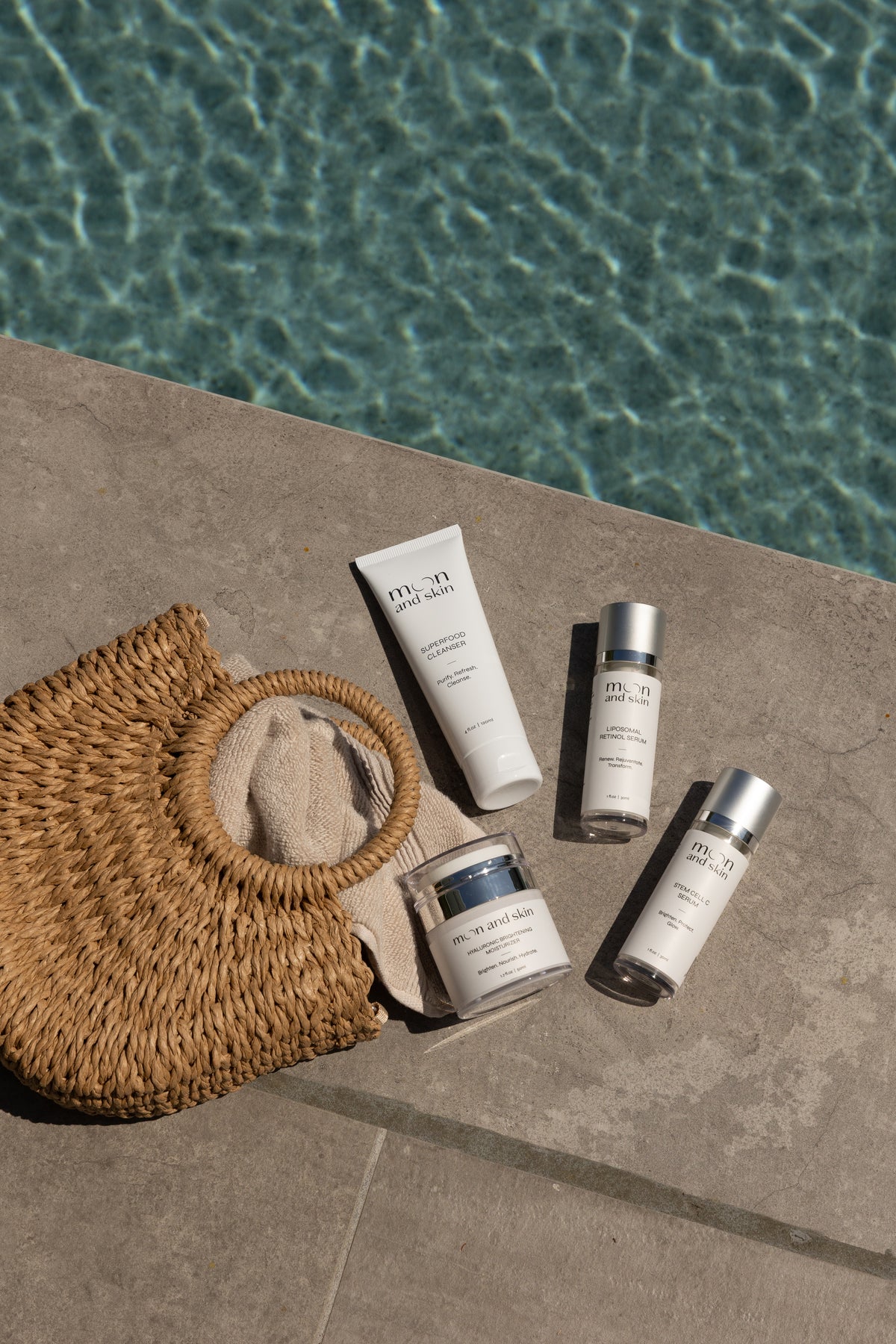Table of Contents
Introduction
Did you know that our skin naturally loses about 1% of its collagen each year after the age of 20? This gradual decline can lead to visible signs of aging, such as fine lines, wrinkles, and uneven texture. For many of us, finding effective ways to combat these changes is a priority. One ingredient that has gained significant attention in the skincare world for its anti-aging benefits is retinol.
At Moon and Skin, we understand that navigating the world of skincare can be overwhelming, especially when it comes to integrating powerful ingredients like retinol into your existing routine. Our mission is to provide clean, thoughtful skincare for every phase of life, and we believe that education is key to empowering our community. In this blog post, we will explore how to incorporate retinol into your skincare routine, ensuring that you maximize its benefits while minimizing potential side effects.
We'll cover the science behind retinol, how to start using it, tips for application, potential side effects, and complementary products to enhance your results. By the end of this post, you’ll have a comprehensive understanding of how to effectively include retinol in your regimen, promoting healthier, more youthful skin.
What is Retinol?
Retinol is a derivative of vitamin A and belongs to a class of compounds known as retinoids. It is celebrated for its ability to accelerate skin cell turnover, improve texture, reduce the appearance of fine lines and wrinkles, and even fade dark spots caused by sun damage or acne scars. Essentially, retinol works by promoting the shedding of old skin cells and stimulating the production of new ones, leading to a fresher, more youthful complexion.
Key Benefits of Retinol
- Improves Skin Texture: By accelerating cell turnover, retinol helps to smooth the skin's surface, reducing the appearance of rough patches and promoting a more even tone.
- Reduces Fine Lines and Wrinkles: Retinol encourages collagen production, which helps to plump the skin and diminish the visibility of fine lines.
- Fades Dark Spots: Regular use of retinol can help to lighten hyperpigmentation and even out skin tone.
- Controls Acne: By preventing clogged pores and reducing oil production, retinol can be an effective treatment for acne-prone skin.
How Does Retinol Work?
Think of retinol as a catalyst for skin renewal. When applied topically, it penetrates the skin and binds to specific receptors in skin cells, influencing gene expression that promotes cell turnover and collagen synthesis. This process not only helps in reducing the signs of aging but also enhances overall skin health.
Starting Your Retinol Journey
Incorporating retinol into your skincare routine doesn’t need to be daunting. Here, we’ll outline a step-by-step guide to ensure a smooth transition.
1. Choosing the Right Retinol Product
At Moon and Skin, we recommend our Liposomal Retinol Serum. This product is formulated with Centersome®RL liposomal complex, ensuring maximum efficacy with minimal irritation. It’s an excellent choice for both beginners and seasoned users alike.
2. Patch Test
Before fully committing to retinol, we suggest performing a patch test. Apply a small amount of the product to a discreet area of your skin, such as behind the ear or on your wrist. Wait 24 hours to see if any irritation occurs. If you experience redness or discomfort, it may be best to consult with a skincare professional before proceeding.
3. Start Slow
For those new to retinol, it’s crucial to ease into it. Begin by applying your retinol product once a week in the evening, gradually increasing the frequency as your skin adjusts. A common method is the "1-2-3 rule": start with one application per week for the first week, increase to two applications in the second week, and three in the third week. After that, you can aim for every other night if your skin tolerates it well.
4. Application Technique
To maximize the effectiveness of retinol while minimizing irritation, follow these simple steps:
- Cleanse: Start with a gentle cleanser, like our Superfood Cleanser, which nourishes the skin while effectively removing impurities.
- Dry: Ensure your skin is completely dry before applying retinol. This helps reduce the risk of irritation.
- Apply: Use a pea-sized amount of retinol and gently massage it onto your face, avoiding sensitive areas like the eyes and mouth.
- Moisturize: Follow up with a hydrating moisturizer, such as our Hyaluronic Brightening Moisturizer, to lock in moisture and help combat potential dryness.
5. Monitor Your Skin
Pay attention to how your skin responds after incorporating retinol. It’s normal to experience some dryness, redness, or peeling initially, as this is part of the retinization process. However, if you experience severe irritation, reduce the frequency of application or consult a dermatologist.
Understanding Side Effects
While retinol is a powerful ingredient, it can also lead to some side effects as your skin adjusts. Here are the most common ones and how to manage them:
- Dryness and Flakiness: This can occur as your skin adapts to increased cell turnover. Ensure you are using a hydrating moisturizer and consider layering it over your retinol at first.
- Redness and Irritation: If you notice persistent redness, reduce the frequency of application or switch to a lower concentration of retinol.
- Sun Sensitivity: Retinol can make your skin more sensitive to the sun. Always apply a broad-spectrum sunscreen during the day, even when it’s cloudy.
Complementary Ingredients to Use with Retinol
To enhance your skincare routine, consider pairing retinol with other beneficial ingredients:
- Hyaluronic Acid: This ingredient is a powerhouse for hydration and can help mitigate the dryness often associated with retinol use. Incorporating our Hyaluronic Brightening Moisturizer can provide the hydration your skin craves.
- Vitamin C: While both retinol and vitamin C have incredible antioxidant properties, they are best used at different times of day. We recommend using vitamin C in the morning and retinol in the evening to maximize their benefits.
- Ceramides: These help to restore the skin’s barrier and retain moisture, making them an excellent pairing with retinol to prevent irritation.
Building a Full Skincare Routine
To achieve optimal results from your skincare routine, it’s essential to create a balanced regimen. Here’s a suggested routine that incorporates our core products:
- Cleansing: Start with our Superfood Cleanser to remove impurities and prepare your skin for treatment.
- Toning (optional): If you use a toner, apply it after cleansing.
- Retinol Application: Apply your Liposomal Retinol Serum to target signs of aging and improve skin texture.
- Moisturize: Follow up with our Hyaluronic Brightening Moisturizer to hydrate and brighten your skin.
- Protect: Don’t forget to apply sunscreen during the day to protect your skin from UV damage.
Conclusion
Incorporating retinol into your skincare routine can be a transformative step towards achieving healthier, more youthful skin. We hope this guide has provided you with the knowledge and confidence to start your retinol journey. Remember to start slow, monitor your skin’s response, and pair retinol with complementary products to enhance its benefits.
At Moon and Skin, we are committed to providing clean, thoughtful skincare for every phase of life. Our Bundle & Save collection allows you to build a full routine at a better value, making it easier to embrace your skincare journey with confidence.
FAQ
1. How often should I use retinol? Start with once a week and gradually increase frequency based on your skin’s tolerance, up to every other night.
2. Can I use retinol during the day? It’s best to use retinol at night as it can make your skin more sensitive to sunlight.
3. What should I do if my skin becomes irritated? Reduce the frequency of application and ensure you are using a hydrating moisturizer. If irritation persists, consult a dermatologist.
4. Can I use retinol with other active ingredients? Yes, but avoid using retinol and strong exfoliants together. Pair it with hydrating ingredients like hyaluronic acid and ceramides for optimal results.
5. How long does it take to see results from retinol? Most users begin to see improvements in their skin texture and tone within 12 weeks of consistent use. Be patient, as retinol is most effective over time.
By following these guidelines and integrating our thoughtfully crafted products, we look forward to supporting you on your skincare journey!







